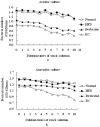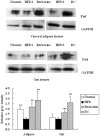Effects and action mechanisms of berberine and Rhizoma coptidis on gut microbes and obesity in high-fat diet-fed C57BL/6J mice - PubMed (original) (raw)
Effects and action mechanisms of berberine and Rhizoma coptidis on gut microbes and obesity in high-fat diet-fed C57BL/6J mice
Weidong Xie et al. PLoS One. 2011.
Abstract
Gut microbes play important roles in regulating fat storage and metabolism. Rhizoma coptidis (RC) and its main active compound, berberine, have either antimicrobial or anti-obesity activities. In the present study, we hypothesize that RC exerts anti-obesity effects that are likely mediated by mechanisms of regulating gut microbes and berberine may be a key compound of RC. Gut microbes and glucose and lipid metabolism in high-fat diet-fed C57BL/6J (HFD) mice in vivo are investigated after RC and berberine treatments. The results show that RC (200 mg/kg) and berberine (200 mg/kg) significantly lower both body and visceral adipose weights, and reduce blood glucose and lipid levels, and decrease degradation of dietary polysaccharides in HFD mice. Both RC and berberine significantly reduce the proportions of fecal Firmicutes and Bacteroidetes to total bacteria in HFD mice. In the trial ex vivo, both RC and berberine significantly inhibit the growth of gut bacteria under aerobic and anaerobic conditions. In in vitro trials, both RC and berberine significantly inhibit the growth of Lactobacillus (a classical type of Firmicutes) under anaerobic conditions. Furthermore, both RC and berberine significantly increase fasting-induced adipose factor (Fiaf, a key protein negatively regulated by intestinal microbes) expressions in either intestinal or visceral adipose tissues. Both RC and berberine significantly increase mRNA expressions of AMPK, PGC1α, UCP2, CPT1α, and Hadhb related to mitochondrial energy metabolism, which may be driven by increased Fiaf expression. These results firstly suggest that antimicrobial activities of RC and berberine may result in decreasing degradation of dietary polysaccharides, lowering potential calorie intake, and then systemically activating Fiaf protein and related gene expressions of mitochondrial energy metabolism in visceral adipose tissues. Taken together, these action mechanisms may contribute to significant anti-obesity effects. Findings in the present study also indicate that pharmacological regulation on gut microbes can develop an anti-obesity strategy.
Conflict of interest statement
Competing Interests: The authors have declared that no competing interests exist.
Figures
Figure 1. Effects of RC and berberine on (a) body weight and (b) visceral adipose tissue weight in HFD mice.
“Normal”, normal chow diet-fed mice; “HFD”, high-fat diet-fed control mice; “berberine”, berberine-treated HFD mice; “RC”, _Rhizoma coptidis_-treated HFD mice. Data were expressed as Mean±S.D. (n = 10), *P<0.05, **P<0.01 vs. HFD controls.
Figure 2. Effects of RC and berberine on 16SrRNA gene relative expressions of (a) Bacteroides/total bacteria and (b) Firmicutes/total bacteria in feces of HFD mice.
“Normal”, normal chow diet-fed mice; “HFD”, high-fat diet-fed control mice; “berberine”, berberine-treated HFD mice; “RC”, _Rhizoma coptidis_-treated HFD mice. Data were expressed as Mean±S.D. (n = 6), *P<0.05, **P<0.01 vs. HFD controls.
Figure 3. Effects of RC and berberine on growth of fecal bacteria ex vivo under (a) aerobic and (b) anaerobic conditions.
“Normal”, normal chow diet-fed mice; “HFD”, high-fat diet-fed control mice; “Berberine”, Berberine-treated HFD mice; “RC”, Rhizoma Coptidis-treated HFD mice (n = 6).
Figure 4. Effects of (a) berberine and (b) RC on the growth of Lactobacillus sp. under anaerobic conditions in vitro.
Figure 5. Effects of RC and berberine on Fiaf protein expressions in intestinal and adipocyte tissues.
“Normal”, normal chow diet-fed mice; “HFD”, high-fat diet-fed control mice; “berberine”, berberine-treated HFD mice; “RC”, _Rhizoma coptidis_-treated HFD mice. Data were expressed as Mean±S.D. (n = 6), *P<0.05, **P<0.01 vs. HFD controls.
Figure 6. Effects of RC and berberine on gene expressions in visceral adipose tissues and livers.
“Normal”, normal chow diet-fed mice; “HFD”, high-fat diet-fed control mice; “berberine”, berberine-treated HFD mice; “RC”, _Rhizoma coptidis_-treated HFD mice. Data were expressed as Mean±S.D. (n = 6), *P<0.05, **P<0.01 vs. HFD controls.
Figure 7. HPLC fingerprint of ethanol extracts of Rhizoma coptidis (RC).
Chromatogram conditions: Kromasil C18 column (5 µm, 4.6 mm×250 mm), column temperature, 30°C; mobile phase, acetonitrile: H2O (0.05 M KH2PO4, pH 3.0) = 30∶70 (v/v); elution rate, 1 ml/min; detector wavelength, 345 nm. Peak “1”, berberine (content, 24.2%).
Similar articles
- Effects of resveratrol on gut microbiota and fat storage in a mouse model with high-fat-induced obesity.
Qiao Y, Sun J, Xia S, Tang X, Shi Y, Le G. Qiao Y, et al. Food Funct. 2014 Jun;5(6):1241-9. doi: 10.1039/c3fo60630a. Epub 2014 Apr 11. Food Funct. 2014. PMID: 24722352 - Gut carbohydrate metabolism instead of fat metabolism regulated by gut microbes mediates high-fat diet-induced obesity.
Li M, Gu D, Xu N, Lei F, Du L, Zhang Y, Xie W. Li M, et al. Benef Microbes. 2014 Sep;5(3):335-44. doi: 10.3920/BM2013.0071. Benef Microbes. 2014. PMID: 24675232 - Red pitaya betacyanins protects from diet-induced obesity, liver steatosis and insulin resistance in association with modulation of gut microbiota in mice.
Song H, Chu Q, Yan F, Yang Y, Han W, Zheng X. Song H, et al. J Gastroenterol Hepatol. 2016 Aug;31(8):1462-9. doi: 10.1111/jgh.13278. J Gastroenterol Hepatol. 2016. PMID: 26699443 - Modulating gut microbiota as an anti-diabetic mechanism of berberine.
Han J, Lin H, Huang W. Han J, et al. Med Sci Monit. 2011 Jul;17(7):RA164-7. doi: 10.12659/msm.881842. Med Sci Monit. 2011. PMID: 21709646 Free PMC article. Review. - Impact of leucine on energy balance.
McAllan L, Cotter PD, Roche HM, Korpela R, Nilaweera KN. McAllan L, et al. J Physiol Biochem. 2013 Mar;69(1):155-63. doi: 10.1007/s13105-012-0170-2. Epub 2012 Apr 26. J Physiol Biochem. 2013. PMID: 22535285 Review.
Cited by
- Natural Dietary and Herbal Products in Anti-Obesity Treatment.
Sun NN, Wu TY, Chau CF. Sun NN, et al. Molecules. 2016 Oct 11;21(10):1351. doi: 10.3390/molecules21101351. Molecules. 2016. PMID: 27727194 Free PMC article. Review. - Antioxidant and anti-inflammatory activities of berberine in the treatment of diabetes mellitus.
Li Z, Geng YN, Jiang JD, Kong WJ. Li Z, et al. Evid Based Complement Alternat Med. 2014;2014:289264. doi: 10.1155/2014/289264. Epub 2014 Feb 11. Evid Based Complement Alternat Med. 2014. PMID: 24669227 Free PMC article. Review. - Rhizoma Coptidis and Berberine as a Natural Drug to Combat Aging and Aging-Related Diseases via Anti-Oxidation and AMPK Activation.
Xu Z, Feng W, Shen Q, Yu N, Yu K, Wang S, Chen Z, Shioda S, Guo Y. Xu Z, et al. Aging Dis. 2017 Dec 1;8(6):760-777. doi: 10.14336/AD.2016.0620. eCollection 2017 Dec. Aging Dis. 2017. PMID: 29344415 Free PMC article. Review. - Ananas comosus L. Leaf Phenols and p-Coumaric Acid Regulate Liver Fat Metabolism by Upregulating CPT-1 Expression.
Xie W, Zhang S, Lei F, Ouyang X, Du L. Xie W, et al. Evid Based Complement Alternat Med. 2014;2014:903258. doi: 10.1155/2014/903258. Epub 2014 Aug 12. Evid Based Complement Alternat Med. 2014. PMID: 25197313 Free PMC article. - Herbal Medicine for the Treatment of Obesity: An Overview of Scientific Evidence from 2007 to 2017.
Liu Y, Sun M, Yao H, Liu Y, Gao R. Liu Y, et al. Evid Based Complement Alternat Med. 2017;2017:8943059. doi: 10.1155/2017/8943059. Epub 2017 Sep 25. Evid Based Complement Alternat Med. 2017. PMID: 29234439 Free PMC article. Review.
References
- Rokholm B, Baker JL, Sørensen TI. The levelling off of the obesity epidemic since the year 1999–a review of evidence and perspectives. Obes Rev. 2010;11:835–846. - PubMed
- Powell TM, Khera A. Therapeutic approaches to obesity. Curr Treat Options Cardiovasc Med. 2010;12:381–395. - PubMed
- Li ZX, Wang XH, Zhao JH, Yang JF, Wang X. Studies on in vitro antibacterial activity of Coptis chinensis against 252 strains inclinic with mueller-hinton agar. Zhong Cao Yao. 2001;32:337–339. [Article in Chinese]
- Shi QM, Shen P, Chen LF, He YW. Research of screening the anti-virus herbs. Zhong Guo Dong Wu Bao Jian. 2003;9:22–23. –29. [Article in Chinese]
Publication types
MeSH terms
Substances
LinkOut - more resources
Full Text Sources
Other Literature Sources
Medical






